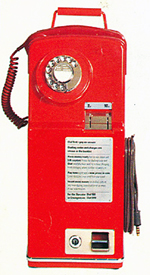 |
The mechanization of the UK's Trunk Network was planned and executed over a very long period, as growth in call traffic necessitated changes in the scheme. |
For each call made under the evolving Mechanized Trunk System, the operator looked up the local routing codes from a list and dialled the necessary digits on the automanual board to connect the caller to the distant exchange. However, the routes between the exchanges and the digits dialled varied depending upon the originating and terminating exchanges. Thus although the automatic network was in place, a uniform method of call routing was required to enable ordinary subscribers to easily dial their own calls, without the use of complex code books.
G R A C E
The Group Routing And Charging Equipment, better known as GRACE, was the solution. In later years this was recognised by its more proper name of an RT or Register-Translator, which examined the digits dialled by the subscriber and converted them into the correct routing codes to complete the call.
The 1960's Plan
In 1960, to relieve the larger Zones of some of the through-traffic, it was planned to introduce 6 Sub-Zones. These would collect calls from the Trunk Group Centres of part of the Zone and route them to any destination to which the Sub-Zones had direct trunk circuits.
Thus in the 1960s plan, although some of the locations had changed, there were still 18 Zone Centres (as in the 1947 list), but supplemented by the 6 Sub-Zone Centres.
The 6000 or so local telephone exchanges were then served by:
|
The Auxiliary Network
Thus as the Mechanized Trunk System grew with the increase in both subscribers and traffic, extra auxiliary routes between the Trunk Group Centres were provided. When Register Translators (RTs) began to be installed, it was economical not only to provide them in the existing Trunk Group Centres (TGCs) but, in additional exchanges as well. The RT control points were named, Group Switching Centres (GSCs).
Unlike TGCs, the GSCs were not fully interlinked and could not be classed as a basic network, so the term Auxiliary Network was used to describe the new RT controlled network.
At this stage, a single operator at a TGC could set up a long distance call routed over several Trunk or Zone Centres, whereas this had previously required an operator at each Trunk Centre.
Transmission Limits
The first phase of STD was designed to use the same circuits that the operators used to connect calls between exchanges, i.e. the Mechanized Trunk System which was developing into the Auxiliary Network.
However, although this system used high grade 4-wire circuits for the transmission of speech, (2 wires in each direction), only a single pair was used for signalling, i.e. dialling and control of the call. This was satisfactory when used by trained operators, but the inherent transmission losses and subsequent post dialling delays would have lead to misrouted calls when used in an automatic system under the control of an untrained subscriber. In fact at one time it was thought that the setting up of a complex long-distance call was beyond the capability of some telephone subscribers.
Under the 1960 Routing, Switching and Transmission Plan, a maximum of only 4 links were allowed in connecting an STD call in order to keep within the transmission and signalling limits. This compared with 7 links for the Mechanized Trunk System which did not need to respond to the vagaries of subscribers unfamiliar with post dialling delay and such like.
Thus the Mechanized Trunk System, together with the use of Register Translators & GRACE gave the facility of STD access for the majority of calls between the Auxiliary Network of routes of the new Group Switching Centres.
The Auxiliary Network:
| 4 links end to end | ||||||||
|
Local Exchange or Local Exchange Principal |
- | GSC | - | GSC | - | GSC | - |
Local Exchange or Local Exchange Principal |
| 2 GSC links (max) | ||||||||
All logos and trade marks are the property of their respective owners and are used on the Light Straw site(s) for review only. Students and researchers are recommended to make their own independent enquiries as to the accuracy of the information contained therein.